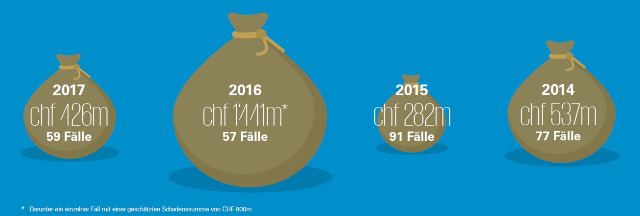White-collar crime: total losses remained below the long-term average in 2017
Last year, 59 cases of white-collar crime were handled in Swiss courts. The damage volume amounted to CHF 426 million. This and more is shown in the current "KPMG Forensic Fraud Barometer".

Last year, 59 cases of white-collar crime in Switzerland caused damage totaling CHF 426 million. Compared to the previous year, however, the volume of damage decreased significantly: from CHF 1.4 billion to CHF 426 million, whereby the all-time high in 2016 was primarily due to one case with a damage volume of CHF 800 million and three cases with a volume of over CHF 125 million each. Compared to the long-term average of CHF 512 million, the claims volume in 2017 is slightly below average.
Large damages in the case of acts committed jointly
The most common offenses in the area of white-collar crime in 2017 were commercial or simple fraud and embezzlement. The motivation for the perpetrators was often to finance a lavish lifestyle or to pay off debts. As in previous years, private investors were the most affected victim group. The damage here amounted to around CHF 162 million, which corresponds to an average damage of CHF 20.2 million per case.

Due to their special position in the company, managers still potentially pose the greatest danger. The analysis shows that managers were responsible for the highest total loss in 2017 (compared to other offender groups), at CHF 120.9 million. Employees had a total loss of CHF 117.4 million, but after deducting an individual case of CHF 100 million, the total drops to CHF 17.4 million, which corresponds to an average loss of CHF 1.7 million. In comparison, the average offense amount for management was CHF 11 million. In 2017, it was again evident that offenses committed jointly by management and employees have particularly serious consequences: The average damage in the three cases amounted to more than CHF 25 million.
High number of unreported cases
The "KPMG Forensic Fraud Barometer" records court cases that have been publicly heard and published in the media every year. It does not include crimes that are reported to the police but never lead to convictions. Moreover, experience shows that the majority of crimes are not even reported. "The reasons for this lie in the companies' fear of reputational damage should the offenses become public," Matthias Kiener, Head of Forensics at KPMG Switzerland, summarizes the problem. "In addition, the fact that in cybercrime, for example, the perpetrators cannot be identified with a reasonable amount of effort plays a decisive role," adds Nico van der Beken, Head of Forensic Technology at KPMG Switzerland.
Source: KPMG









